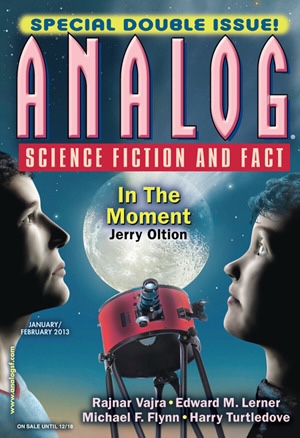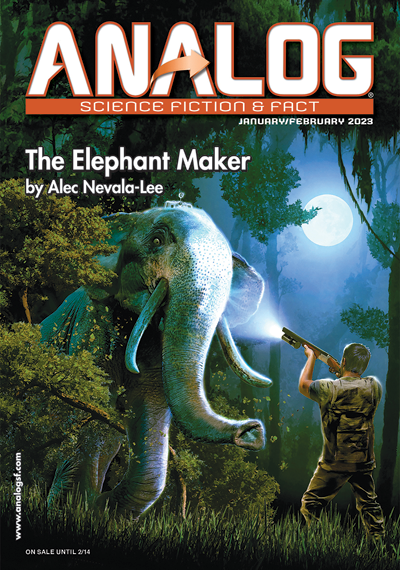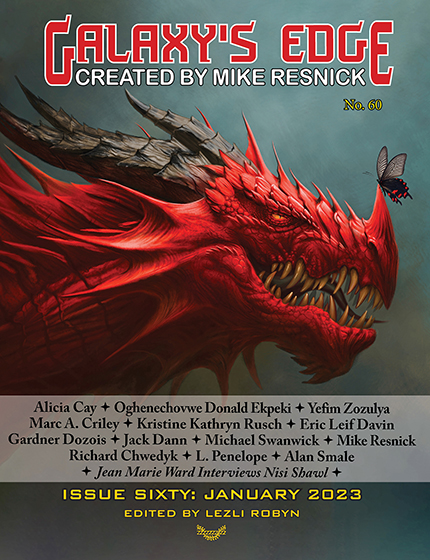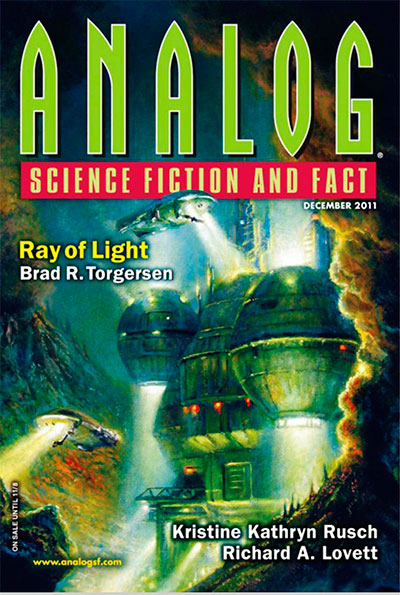-
Buddha Nature by Amy Thomson
This novelette has a bit of an unusual setting. The story takes place entirely in a Buddhist monastery and follows a robot that seeks to achieve enlightenment as a monk.

The robot called Raz is a cataloging robot specially built to absorb and catalogue books. Its previous function turned obsolete, so it sought out the monastery by itself. After some debate between the monks, the robot is accepted in the community as an equal. Not without issues though. Especially one other monk is very adamant that spiritual enlightenment is only for humans and a soul-less unconscious machine should not be allowed.
This simple but effective setup creates a story with lots of philosophical debate about sentience, free will and spiritual topics. A theme that has been explored in countless science fiction stories, and while I haven’t seen one that took place in a religious setting like here, there isn’t much new to add.
While the story is easy to follow and reasonably engaging, I was thinking of the classic Star Trek TNG episode “The Measure Of A Man” which deals with lots of the same questions and uses the same type of conflict to setup the arguments for and against - and ultimately does it better.
Read in Analog January/February 2013
Rating: 3+ -
Time Out by Edward M. Lerner
One of the great things about going back to older issues of a magazine is when you read a great story that you would otherwise have missed, because it hasn’t been reprinted much. This time travel novella is one such story.

The setup of this story could almost have come out of the same magazine in the 1930s. Jonas is the typical mad scientist. He is working alone because his fellow researchers at the university have turned their back on him and his unorthodox interests. He is claiming to be very close to discovering time travel. He needs an assistant at his lab and along comes Peter, an ex-convict willing to accept the low paying job but with full accommodation at the scientists’ lab.
The version of time travel that Jonas invents is the one where it is possible to send objects back in time. But only if there is a compatible receiver running in that time. Neatly explaining why no time travelers from the future have been seen yet. In all this, Peter is doing his job as a general handyman while being equally intrigued and perplexed by what is going on. He becomes somewhat friends with Jonas and they go through the usual motions of discussing all the well known paradoxes of time travel.
As the story moves forward and Jonas successfully manages to get messages from his future self - with some good stock tips among other things - Peter becomes increasingly worried about the consequences of trying to change the course of history. Butterfly effect and all that.
While the story starts kinda light, the tone gets progressively darker. The stakes are ramped up and the cascading effects of messing with time lines become harder to ignore. While this story doesn’t do much new with how it deals with time travel paradoxes, it handles them well and understandable. The author is aware that the typical Analog reader likely knows the genre well enough, and he uses that to take what might seem at first to be the usual route for time travel stories, but the ending was something different - and quite moving I might add. Very much recommended.
Read in Analog January/February 2013
Rating: 4 -
The Area Under the Curve by Matt McHugh
The setup for this is an Earth that has become increasingly unlivable so humanity has planned a big generation ship, but only a limited number of people can go.

The story follows a couple who has managed to get a seat on the generation ship through hard work and excelling in basically every imaginable test. It is clear that only the top 0.001% have a chance. They want only the absolute “best” on this ship. I am making quotes around the “best” part because one of the key points of the story, is whether intelligence is the only and proper way of determining who are worthy of making the foundation for the survival of the human race. The problem arises when their child is deemed not excellent enough to get a seat on the ship. He is just an average child. The father thinks they should send him back to Earth to his grandparents, so they can retain their place on the generation ship. The mother has a different opinion.
I found this to be a story with plenty of potential for some exploration into personal morales and what is for the greater good. I frequently see stories like this in Analog that really aims for tackling complex and interesting humanistic issues. The downside is that often the result is rather superficial. The story jumps straight at the problem at hand and doesn’t waste any time, but it comes with a lack in character development. We are just told how they think and feel, without having a good grasp of who these characters are, their motivations or why they act like they do. Which is a shame, because the actual premise is interesting, but without any sort of character depth it isn’t as engaging as it could be.
Read in Analog January/February 2023
Rating: 2+ -
Neighborhood Watch by H.G. Stratmann
A delightfully silly story with the amusing premise that all the planets in the solar system are inhabited with intelligent life, only humans don’t know it.

All the different species in the Solar System have some sort of union where they discuss things and what to do with the increasingly curious humans. It was easy enough to fool the scientists of Earth when they invented telescopes, but with spaceships surveying planets and landrovers on Mars, the need for complex holographic illusions has increased. The story evovles around the martian Twee’ll (a clear reference to Tweeel from Stanley G. Weinbaums “A Martian Odyssey”) and its dealings with the other solar species about how to proceed with the Earth situation.
This is the type of story I always love to see in Analog. There should be room for these less than serious stories - as long as they are as entertaining as this one.
Read in Analog January/February 2013
Rating: 4 -
Direct Message by Tom R. Pike
A single tweet on Twitter can have massive impacts in the real world. This amusing little story begins with a poll on Twitter asking which region should be destroyed by a heat ray, with Appalachia “winning” by a large margin.

The story is told by a man who has been engaging with this specific Twitter account for a while. He discovers that it is not just a joke account, but actual aliens who really have a death ray capable of killing everything in that region with 25 million people. But maybe he can talk them into a different deal.
As might have been guessed, this is a somewhat quirky story written in a humorous light style, while still keeping it serious enough not to be completely silly. We only see the aliens through correspondence through Twitter - still, I found them to be rather convincing even though the whole scenario is a bit far-fetched.
Read in Analog January/February 2023
Rating: 3 -
Descartes’s Stepchildren by Robert Scherrer
This was a very Analog-esque story. Scientists discover something incredible but the consequences are more messy and complicated. Here we delve into a test for human consciousness.

John and his research partner have developed a special MRI scan that can detect where the consciousness lies in the brain. The twist is that their tests show that about 20% of human test subjects are not really conscious. This discovery hits Johns partner hard, because according to the test his wife’s brain shows no activity in the consciousness-center. She is a what is named a Blank in the story. John wants to publish their results anyway and the world changes drastically when their findings become public knowledge.
A test becomes widely available and many people start to test themselves, their kids, future employees and so on. The Blanks quickly become second-rate citizens unable to get a job or stay in a relationship. Many kids ends up as orphanages because their parents don’t want them. John gets rich for his patents on the tests, but he has increasingly moral qualms about the whole thing.
This story has a lot to unpack. There are plenty of philosophical and existential questions to ponder with the concept of human consciousness. I like the general premise of this story, but the consequences to the greater society are only dealt with in broad headlines since the primary focus is on John. Also, I found that their test was a little too easily accepted as scientific fact. Of course these simplifications are needed for the story to work, but I wasn’t totally convinced of what happened. My reading experience might have been hampered a bit by reading “The Algorithms for Love” the same day. It has a completely different approach to dealing with humans free will, but managed to create a more personal depth to it, whereas this story had a broader and distanced perspective.
Read in Analog January/February 2013
Rating: 3 -
The Algorithms for Love by Ken Liu
Ken Liu is a gifted writer that has a talent for combining hard science fiction concepts with human emotions in beautiful written stories. This story from 2004 is among his best.
The story follows Elena who is a genius with robotics and language algorithms. She has created a very lifelike robotic doll that is both able to speak almost fluently and has very advanced motoring skill. The doll quickly becomes immensely popular and the company she works for has trouble keeping up with demand. She partners up with Brad, the CEO of the company, and she gets pregnant. Sadly, they lose the child during pregnancy and Elena is unable to get pregnant again. This emotionally devastates Elena and she buries herself in working on a new robotic doll, this time one that resembles a newborn. That too becomes a product sold by the company, with mostly other grieving mothers as customers.
As the story progresses, Elena becomes more and more obsessed with her creations. Working so intense with especially the speaking algorithms, she starts to view the real world in the same algorithmic terms. She knows how her own algorithms work and that everything they produce are mathematically predictable, which she increasingly believe is also true for human behaviour. Basically her worldview breaks down as she questions whether human are even conscious or any different from the artificial intelligence she has created. That everything we do is inherently deterministic. There are some direct references to the Chinese Room argument on the matter.
Liu manages to weave all these philosophical questions about the nature of consciousness into a very beautiful written short story, that has the technology used described in a plausible way while still keeping focus on the human emotions and making them engaging and believable for the reader.
Read in Twenty-First Century Science Fiction Originally published on strangehorizons.com
Rating: 5 -
Eros, Philia, Agape by Rachel Swirsky
This was a real positive surprise. At first I was a bit weary with yet another AI robot human relationship story. 2021 and 2022 has had too many stories with that sort of theme. This story reconfirms my opinion that the best AI robot stories are at least 10 years behind us, even though it is immensely popular now.

We follow Adriana and her relationship with the android Lucien she has bought for companionship. During their together Lucien develops his own personality and they also end up having a child. The plot is minimal, the important stuff is in the development of these three characters and their feelings for each other - especially as Lucien develops more free will. Hence the title of the story with the different types of love.
What I think works exceptionally well here is how it is told with various jumps back and forward in time. We know the outcome, or at least hints of it, but not why or how yet. Even in a relatively short story, the author manages to show us the developments of three personalities at once. The point of view is mostly for Adriana, but the childs and Luciens character development is equally important.
Read in Twenty-First Century Science Fiction, edited by David G. Hartwell
Read online at Tor.com
Rating: 4 -
The Last Man by Eric Leif Davin
This is a pretty short story set in a post-apocalyptic world where a virus has killed almost everyone. A woman is strolling through an abandoned supermarket for supplies when she spots a man. Seeing other people alive is a rare event, so her first response is to flee.

However the man overpowers her, captures her and they go back to where she and another woman lives. The man tries to convince them that they shoudl get pregnant with him, so they can repopulate the Earth - and this will be a spoiler for the ending but I honestly don’t think readers will be missing much, but the women manages to kill him. Apparently they have killed several men before in a similar fashion.
It seems like the story at least to a degree tries to mimmick “Houston, Houston, do you read” by James Tiptree, Jr. with a premise of characterizing men as ultimately violent and misogynistic. Where the classic Tiptree story had fully fleshed out characters and handled the topic with plenty of ambiguity and nuances, this story simply turns the caricature of an incel man up to 11 only to kill him off instantly. All rather pointless and without any depth at all to the topic the story wants to deal with.
Read in Galaxy’s Edge January 2023
Rating: 1 -
The Impossibles by Kristine Kathryn Rusch
Rusch is usually a reliable author of good entertaining stories and this court-drama is no exception. It is part of her Retrieval Artist stories, but I only realized that afterwards and the story is perfectly fine on its own.

The story follows a lawyer trying to do her best in an interspecies court system where humans have to accept being prosecuted by alien law. This has created a very stressful system for the lawyers, where the best case scenario usually is just a reduced sentence, even though the crime is something small like stepping on a flower or simply touching a specific alien.
As what is often a main ingredient in these types court room dramas, a special case comes along that needs some creative thinking and the use of loopholes in some old laws. That aspect of the story is fine, but the highlight for me was the whole background setting, where we get small drops of details about how this whole ordeal is one big diplomatic trade between Earth and various aliens in order to get access to the galactic trade network. Rich people can of course buy their way out of trouble, but regular people just have to accept being judged cruelly by alien laws they have little way of avoiding. In addition, the main character is a likeable type that really tries to good within the system. All in all a fairly straight forward story that mostly goes where you expect it to, but it was an enjoyable and entertaining read.
Read in Analog December 2011
Rating: 3+